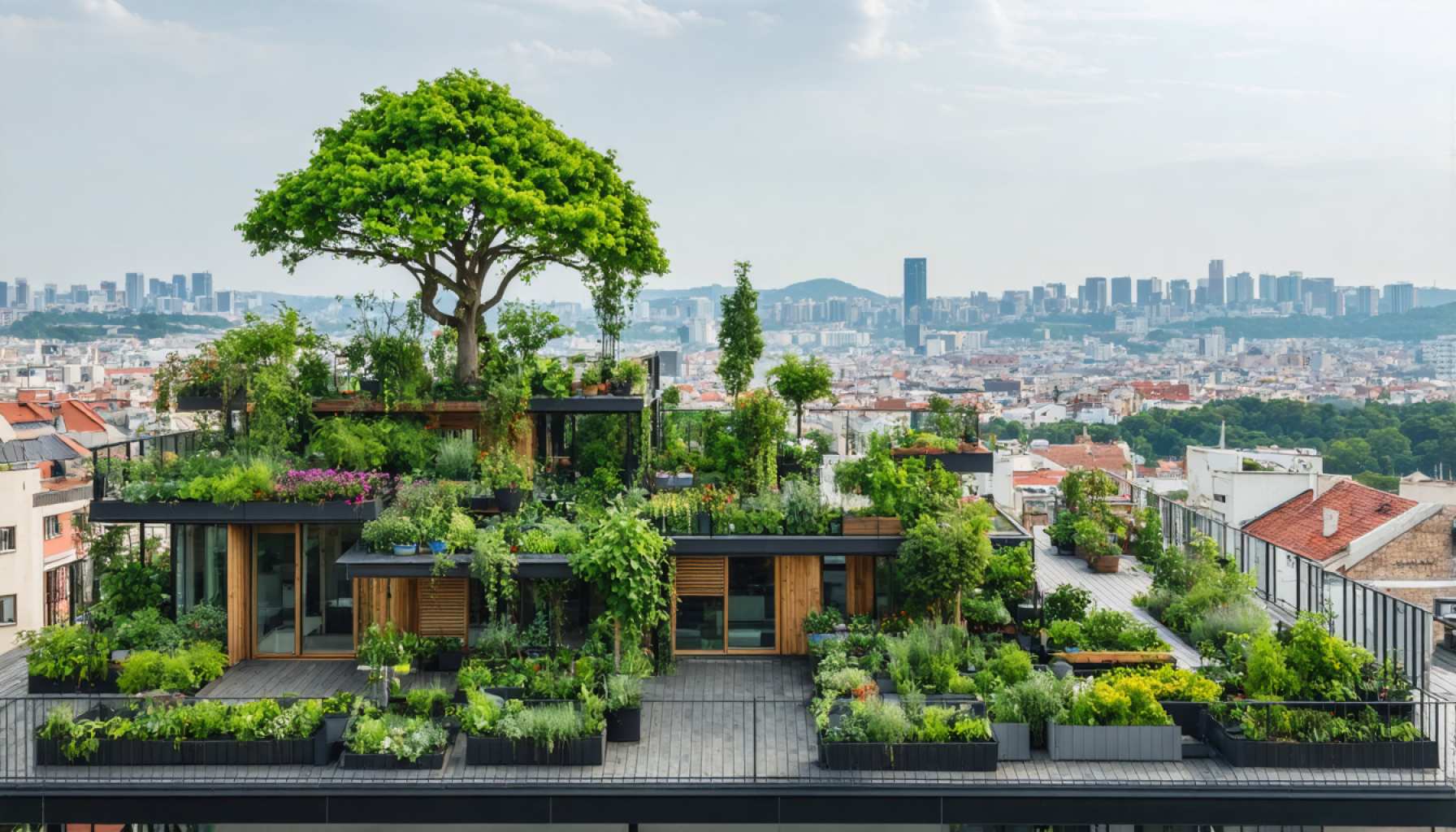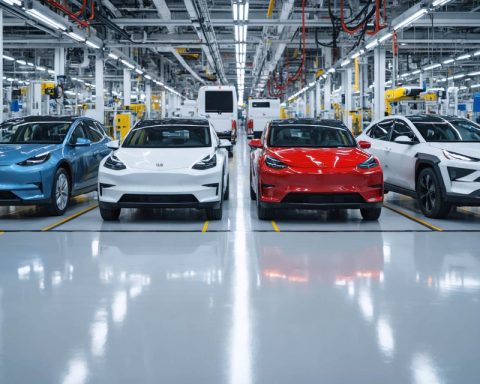- Rooftop gardens are transforming urban areas by enhancing sustainability, improving air quality, and reducing urban heat islands.
- Cities like New York, Tokyo, and Singapore are leading the way in adopting green roofs to counteract the effects of urbanization.
- These gardens support urban agriculture, providing fresh produce and reducing dependence on long supply chains.
- Rooftop gardens enhance biodiversity by creating habitats for wildlife, such as bees and birds, fostering urban ecosystems.
- They help manage stormwater, decreasing pressure on drainage systems and mitigating flood risks.
- Challenges include building regulations and maintenance, but innovations like lightweight soils and hydroponics offer solutions.
- Collaborations among government, private, and community stakeholders promote adoption and overcome challenges.
- Rooftop gardens illustrate a harmonious blend of nature and urban living, paving the way for sustainable city futures.
Concrete jungles stretch as far as the eye can see, yet hidden within these sprawling metropolises lies a quiet revolution — the rise of urban rooftop gardens. Picture vibrant patches of green atop city buildings, teeming with life and providing a breath of fresh air to bustling city streets below. From New York to Tokyo, these skyward gardens are not just beautifying gray skylines; they’re rewriting the narrative of urban sustainability.
Rooftop Gardens: The Urban Oasis
Imagine stepping into a serene refuge high above the city’s noise, where verdant plants sway gently in the breeze. Rooftop gardens are transforming urban landscapes by turning otherwise neglected spaces into thriving ecosystems. Cities like Singapore have embraced this concept wholeheartedly, with green roofs reducing heat and improving air quality — a crucial step in combating urban heat islands that can push city temperatures significantly higher than in surrounding areas.
Nourishment from Above
These aerial gardens are more than just visual spectacles; they’re active contributors to food security. Urban agriculture, particularly rooftop gardening, is gaining traction as a viable solution to food scarcity in densely populated areas. By cultivating fruits, vegetables, and herbs on rooftops, city dwellers can access fresh, home-grown produce, reducing dependency on long supply chains that contribute to carbon emissions.
Sustainability Beyond Soil
Rooftop gardens embody a sustainable ethos beyond merely reducing urban heat and providing food. They contribute to biodiversity by creating habitats for birds, insects, and other wildlife. As bees flit from flower to flower, pollinating plants and supporting ecosystems, they remind us of the interconnectedness of nature even in the heart of our cities. Furthermore, these gardens can absorb stormwater, reducing the burden on urban drainage systems and minimizing flood risks.
Challenges and Opportunities
While the benefits of rooftop gardens are plentiful, challenges remain. Building regulations, weight restrictions, and maintenance costs can be significant hurdles. However, innovation continues to forge pathways around these obstacles. Lightweight soil compositions and hydroponic systems offer promising solutions for buildings unable to support the weight of traditional gardens. Partnerships between governments, private enterprises, and local communities are crucial in navigating these challenges, with several cities offering incentives and grants to promote green roofing.
The Takeaway
Urban rooftop gardens are not just patches of green in gray urban sprawls; they are a testament to humanity’s ability to harmonize with nature in even the most unlikely places. As individuals and communities embrace these gardens, they knit together a tapestry of sustainability that enhances city life. Whether it’s a community garden feeding a neighborhood or a corporate green space providing employees with a tranquil retreat, each rooftop oasis plays a pivotal role in shaping a sustainable urban future.
Engage with your city. Look up. Perhaps the future of sustainable living lies just above you, nestled among the clouds and skyscrapers, waiting to be explored.
The Green Revolution: Unlocking the Potential of Urban Rooftop Gardens
Exploring the Future of Urban Rooftop Gardens
The quiet revolution of urban rooftop gardens is more than just a way to turn gray skylines green; it’s a multifaceted approach to solving some of the most pressing urban challenges. These verdant spaces serve as functional areas contributing to sustainability, biodiversity, and community wellbeing. Let’s dig deeper into the various facets of rooftop gardens and reveal insights not fully explored in the source material.
1. How-To Steps & Life Hacks for Rooftop Gardens
Creating a rooftop garden involves several crucial steps:
– Evaluate the Space: Assess the structural integrity of your rooftop. Consult with professionals to ensure it can support a garden. Consider factors like sunlight exposure and wind patterns.
– Design Your Garden: Choose plants that suit your climate and rooftop conditions. Consider using native species to support local biodiversity.
– Select the Right Medium: Use lightweight soil compositions or hydroponic systems for areas with weight restrictions.
– Plan for Irrigation: Implementing a drip or automated irrigation system can ensure your plants receive consistent watering.
– Maintain Regularly: Routine maintenance like pruning, fertilizing, and pest management keeps your garden flourishing.
2. Real-World Use Cases of Rooftop Gardens
– Urban Agriculture Hubs: In cities like Toronto, community rooftop gardens provide fresh produce for local markets and restaurants.
– Corporate Green Spaces: Companies like Google implement rooftop gardens to enhance employee wellness and reduce stress levels.
– School Educational Gardens: Schools utilize these gardens as living classrooms to teach students about sustainability and biology.
3. Industry Trends and Market Forecasts
The urban rooftop garden market is poised for growth as cities prioritize sustainable development. According to a Grand View Research report, the green roof market is expected to reach USD 21.76 billion by 2027, driven by incentives and sustainable urban planning. More cities are likely to adopt policies similar to those in Singapore, which encourages extensive green roofing.
4. Reviews & Comparisons: Hydroponics vs. Traditional Soil
While traditional soil gardening remains popular, hydroponic systems are gaining traction due to their efficiency and lower weight load. Hydroponics can use up to 90% less water than soil gardening and can be more productive. However, it requires an initial investment in equipment and maintenance knowledge.
5. Challenges and Limitations
– Cost Considerations: The initial setup cost and ongoing maintenance expenses can be a barrier. However, long-term benefits such as energy savings and increased property value often offset these costs.
– Regulatory Hurdles: Building codes and zoning laws can impede installation. Advocacy and partnerships with local authorities can help navigate these challenges.
6. Sustainability and Biodiversity
Rooftop gardens are a haven for urban wildlife. They enhance urban biodiversity by providing habitats for pollinators like bees and butterflies. Green roofs have been shown to improve air quality by filtering pollutants and capturing dust particles.
7. Actionable Recommendations
To maximize the benefits of rooftop gardens, consider the following tips:
– Start Small: Begin with container gardens or modular green roofs if space and resources are limited.
– Engage the Community: Partner with local organizations and neighbors to create a community garden. This fosters community spirit and shared responsibility.
– Explore Incentives: Look for local government subsidies or grants that support green roofing projects.
Engage actively with these urban oases and contribute to the sustainable transformation of cityscapes around the world. Remember, the next big leap in sustainable living might be just above you.
For further reading on urban sustainability and innovative green solutions, visit National Geographic and Environmental Protection Agency.
















